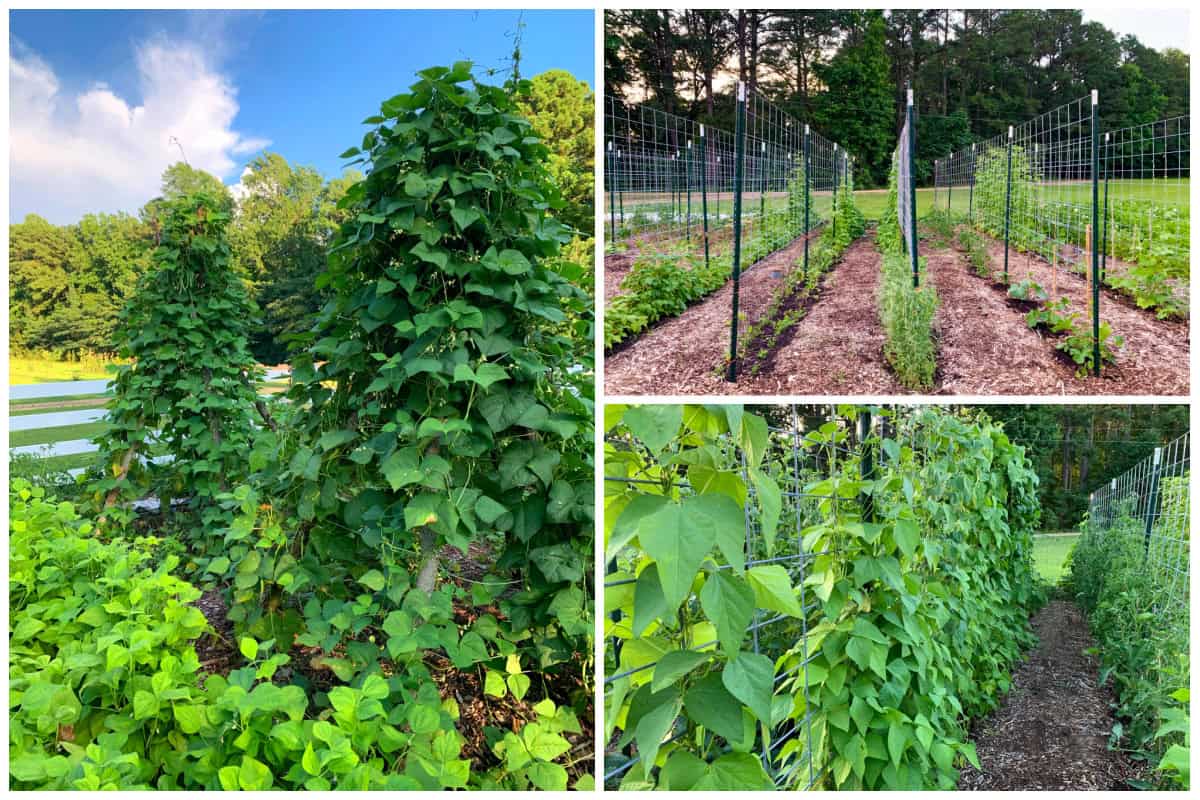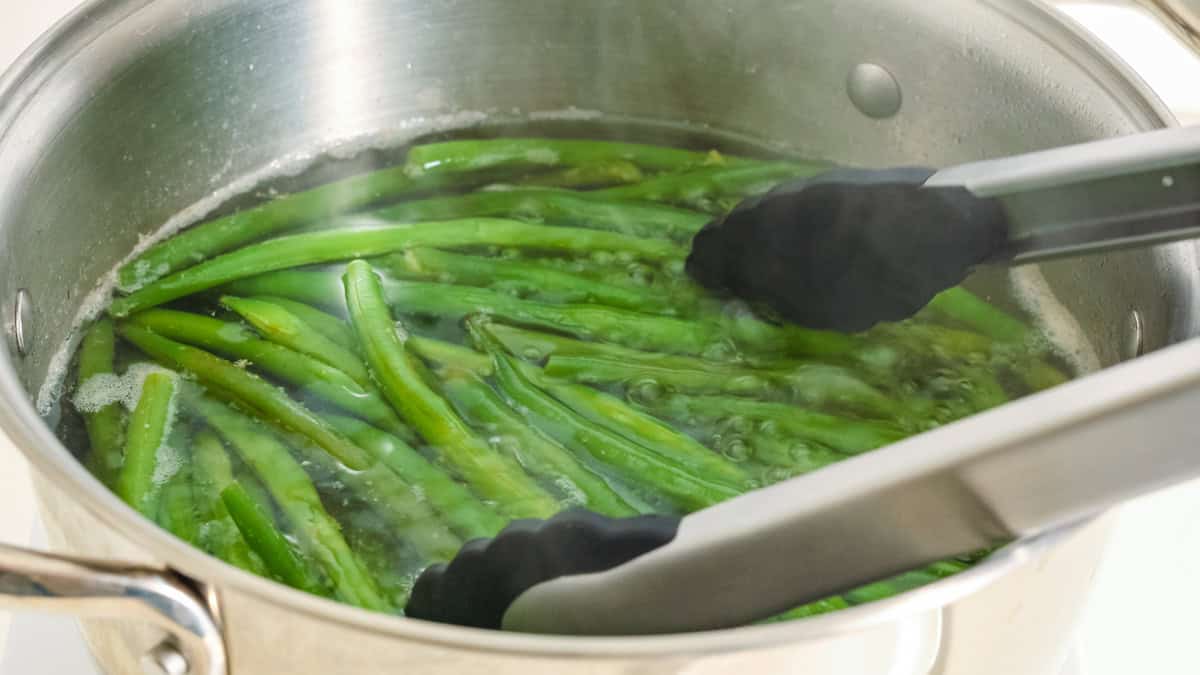How to Cook Green Beans
This post may contain affiliate links. See my disclosure policy.
Learn how to cook green beans to get those perfectly crisp-tender and vibrantly beautiful veggies to enjoy in a variety of tasty side dishes or incorporating into other bean-celebrating recipes!

I’m approaching 11 years of blogging here at The Daring Gourmet and something you may not know about me is that I’m also The Bean Queen. If you have questions about growing beans, bean varieties, harvesting beans, storing beans, saving bean seeds, processing beans, freezing beans, freeze-drying beans, drying beans, pickling beans, canning beans, and cooking beans…*gasp for breath*…I’ve got you covered. And today I’m going to share a step-by-step tutorial on how to cook green beans, or any snap/string bean variety.
But first, given that after 11 years I’ve only just revealed my alter ego, I should introduce you to my garden. At least the bean portion of it. (My additional alter egos of Squash Queen, Tomato Queen, Melon Queen, and Potato Queen will have to wait for another time.) But if you don’t care about the bragging rights to the bean queendom thing, just keep scrolling down to the tutorial portion of the blog post. I won’t be offended. I’ll just go outside and make some new friends of the bean kind.

I’ve been an avid gardener for many years. Even as a kid I always had an interest in growing things and my parents were great about giving me my own areas of the yard to dig and plant in, even when it didn’t look the prettiest. Those small-scale childhood experiments have since expanded into large-scale, serious gardening.
I exclusively use a no-till gardening method. I have my own “worm farm” and brew my own worm tea. I’ve regularly got the bubbler going brewing my own microorganism-rich compost teas. I read books about and geek out on soil microbiology. And I get a pretty giddy when I see mushrooms and mycorrhiza growing throughout my garden, the sign of good things happening. Yes, I’m what you’d call hard core.
I grow far more than our family can possibly eat (case in point, nearly 1000 pounds of potatoes and 86 melons last season) and what we don’t eat fresh or freeze/freeze dry, we happily give away to friends and neighbors. Part of the joy of gardening for me is sharing the wealth. I grow hundreds of heirloom varieties of virtually every possible vegetable type with over 350 different heirloom varieties in my seed collection from all around the world. One of these days I need to take you on virtual video tour of my garden. But today, since we’re focusing on how to cook green beans, I’ll just give you glimpse of one part of my garden: the “bean garden”.

I have over 40 heirloom bean varieties and I think the most I’ve ever grown simultaneously in the same season is 27. The most beans I’ve picked in a single picking session: 53 pounds in 2 hours. That was two months ago after we got back from spending 2 1/2 weeks in England and I had timed the planting/harvest to coincide with our return. Well, I certainly DID time it well. What I initially thought was a good idea meant a crazy amount of work picking and processing the very day after we flew in, jet-lagged and all! Pole beans, bush beans, string beans, shell beans, snake beans, wing beans, noodle beans – beans of every color and variety from green and yellow to pink and purple. It’s the crazy amount of labor that goes into gardening that most people don’t think about. But when all you see is the fruit of those labors, can you blame them? They’re gorgeous!

How to Cook Green Beans
Alright, let’s get down to it! How to cook green beans…
The basic method for cooking fresh green beans is simple and the end result is something you can enjoy all by itself with a little salt and pepper, or add some additional embellishments like oil, lemon, and other seasonings, or use those cooked beans in any recipe that calls for them. And whichever name you know them by – green beans, snap beans, string beans – and including yellow wax beans, the cooking method is the same.

Step 1: Wash and Trim the Beans
Rinse the beans in a colander and use your fingers or a knife to snap off or trim the ends. You can trim the stem end only or trim both ends. Depending on the bean variety, like a French haricot vert, it looks elegant to leave the pointy end, but it’s strictly a matter of personal preference and how you’re serving them.
Step 2: Blanch the Green Beans
Blanching green beans is key to cooking them properly. Blanching refers to a method of boiling a vegetable for a short period of time until it is crisp-tender and it retains its vibrant green color. That way you can proceed with preparing the beans in additional ways, like pan-frying in oil or butter with seasonings or adding them to a casserole, without them becoming over-cooked. Because nobody likes mushy beans. Not unless you’re making British Mushy Peas. But that’s different.
Bring a pot of generously salted water to a boil. The recommended guideline is 2 tablespoons of salt per quart of water (use kosher or sea salt, table salt has a harsh flavor). It’s almost a brine. This high concentration of salt helps tenderize the beans quickly so that their vibrant color is preserved.
Prepare an ice bath by filling a large bowl with cold water with ice cubes.
Place the beans in the boiling water. If you’re going to eat the beans as is, boil them for about 3-5 minutes until tender but still retaining some crisp (the more slender the diameter of the bean, the less cooking time). The texture should be “snappy” and such that you can bite through it without hearing it squeak. If you plan to cook the beans further after blanching them (like sautéing them in oil, giving them a quick char, or using them in a casserole), boil them for 2-3 minutes.

Step 3: Shock the Green Beans
Use a pair of long tongs to remove the beans and immediately plunge them into the ice bath to chill.

The purpose of plunging the blanched green beans in ice water is stop them from cooking further. This way they will retain their crisp-tenderness and it also locks in their vibrant green color. The ice bath method is also referred to as “shocking” them (no kidding, like stepping from a hot sauna into an ice cold shower, it’s shocking indeed!).

Step 3: Drain the Green Beans
Drain the beans in a colander then place them on paper towels or a clean kitchen towel and blot dry.

And that’s all there’s to it! If not using immediately, you can store the green beans in the fridge for up to 2 days.
At this point you have options: Eat your green beans now, prepare them further by sautéing and seasoning them, or use them in any recipe that calls for green beans. Or you can freeze them for future use (see below).

Freezing Green Beans
To freeze your blanched green beans for future use, let them cool entirely, blot them dry, spread them out on a a lined baking sheet and stick them in the freezer. Freeze for at least an hour until they’re frozen, then transfer them to a freezer bag or freezer container. They will keep for up to 3 months. They can be frozen even longer but their texture will deteriorate over time.
Green Bean Recipes
There are endless ways that you can put your blanched green beans to use. For example, you can sauté them in some oil with garlic, a splash of lemon juice, and some salt and pepper. Or sauté them in butter and sprinkle with herbs or an all-purpose seasoning of your choice (for example, try my Seasoned Salt or Lemon Pepper Seasoning). Or you can simply toss them as is in melted butter or compound butter and serve. And you use them in any recipe that calls for green beans. Here are just a few ideas:
- Four Bean Salad
- Bohnensalat (German Green Bean Salad)
- Green Beans Almondine
- The ULTIMATE Green Bean Casserole!
- Valencian Paella
- Minestrone Soup

And there you go! Now that you know how to cook green beans by blanching and ice shocking them, you have a blank palette for a world of green bean recipes and delicious ways to use them!
Be sure to also check out my tutorial on How to Cook Snap Peas!
Save This Recipe

How to Cook Green Beans
Ingredients
- 1 pound fresh green beans or yellow wax beans
- salted water for boiling (use kosher or sea salt)
Instructions
- Rinse the beans in a colander and use your fingers or a knife to snap off or trim the ends. You can trim the stem end only or trim both ends. Bring a pot of generously salted water to a boil. The recommended guideline is 2 tablespoons of salt per quart of water (use kosher or sea salt, table salt has a harsh flavor). This high concentration of salt helps tenderize the beans quickly so that their vibrant color is preserved. Prepare an ice bath by filling a large bowl with cold water with ice cubes.
- Place the beans in the boiling water. If you're going to eat the beans as is, boil them for about 3-5 minutes until tender but still retaining some crisp (the more slender the diameter of the bean, the less cooking time). The texture should be "snappy" and such that you can bite through it without hearing it squeak. If you plan to cook the beans further after blanching them (like sautéing them in oil, giving them a quick char, or using them in a casserole), boil them for 2-3 minutes.
- Use a pair of long tongs to remove the beans and immediately plunge them into the ice bath to chill. Drain the beans in a colander then place them on paper towels or a clean kitchen towel and blot dry. If not using immediately, you can store the green beans in the fridge for up to 2 days. At this point you have options: Eat your green beans now, prepare them further by sautéing and seasoning them, or use them in any recipe that calls for green beans. Or you can freeze them for future use (see blog post).



















I forgot to include the rating with my comment. Thanks again!
Thank you so much for this information on cooking beans and I loved hearing about your garden. I will be planting a lot more beans this coming season.
Thank you so much, Monica, I’m happy you enjoyed it! <3
I really enjoyed the tour of your “bean garden” and if that’s just the bean portion of it I can only imagine how massive the rest of it must be! I have a garden myself, albeit much smaller, and so I know how much work is involved. I don’t know how you keep up with it all on top of everything else! You sure have a gift for gardening though, everything looks wonderful and those beans really are gorgeous – picture perfect! Great post, great tutorial, as always. Love your blog <3<3<3
Thank you so much, Renae, I’m happy you enjoyed it and I appreciate the compliment <3 And it's always nice to meet a fellow gardener :)